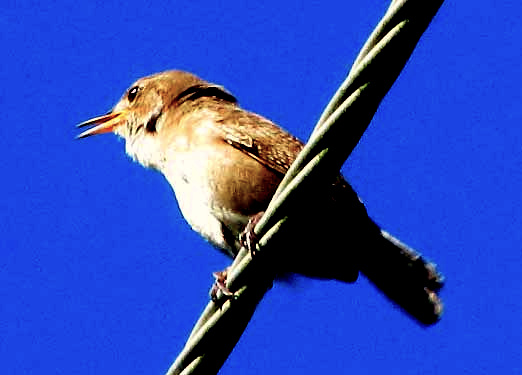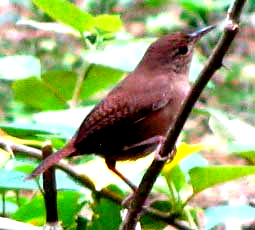Excerpts from Jim Conrad's
Naturalist Newsletter
issued June 18, 2020 from the forest just west of Tepakán; elev. ~9m (~30 ft), N21.053°, W89.052°; north-central Yucatán state, MÉXICO
SOUTHERN HOUSE WREN FROM BELOW As soon as I enter Tepakán, always in the same general area during these bird-nesting days, I hear a song that's accompanied me since my childhood in Kentucky. Howell describes it as "...varied, a scratchy, chortling, warbling and trilled series, usually beginning with a few separate gruff notes." It's a house wren, shown below in mid chortle, a small bird with a big, tireless voice:

from the May 2, 2010 Newsletter issued from Hacienda Chichen Resort beside Chichén Itzá Ruins, central Yucatán, MÉXICO; limestone bedrock, elevation ~39m (~128ft), ~N20.676°, ~W88.569°
SOUTHERN HOUSE WREN

At one time of the year or another House Wrens, TROGLODYTES AEDON, can found throughout the US and southern Canada. In most of that area they're strictly summer nesters, though in the US Deep South they're winter visitors, and in much of the US South they occur only during migration. If you're a "lumper" -- someone who lumps similar looking and maybe intergrading populations into one big species -- you'd say that House Wrens, Troglodytes aedon, occur from Canada to Tierra del Fuego at the tip of southern South America, manifesting along their way several recognizably different local populations. However, if you're a "splitter," tending to recognize those different-looking populations as different species, then you'd say that what we have here isn't the House Wren at all, but rather the Southern House Wren, Troglodytes musculus.
Whether or not our local House Wrens are regular House Wrens or Southern House Wrens, our birds have been awfully busy lately, sometimes seen carrying nesting material in their beaks. Occasionally you hear brief snatches of their pretty chortling, warbling, trilling calls, but mainly you see them rushing about like little flurries of wind-driven brown leaves.
They're pretty shy, to be wrens, so getting a picture has been hard. However, this week I did get one, the one shown above, so you can judge for yourself whether our birds -- darker than those found up North -- deserve to be regarded as a separate species.